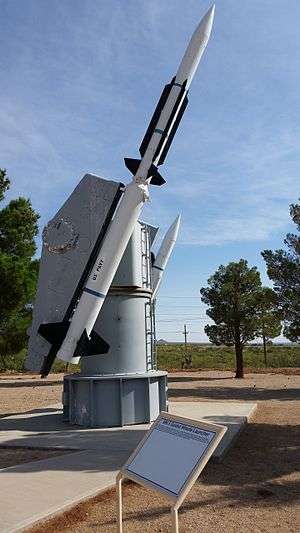USS Desert Ship (LLS-1)
| USS Desert Ship (LLS-1) | |
|---|---|
| Part of Naval Surface Warfare Center | |
| White Sands Missile Range, New Mexico | |
|
| |
| Type | Aboveground facility |
| Site information | |
| Open to the public | No |
| Site history | |
| Built | 1957-1958 |
| Built by | U.S. Navy |
| In use | 1958-Present |
| Garrison information | |
| Garrison | White Sands Missile Range, New Mexico |
| Occupants | Naval Surface Warfare Center |
USS Desert Ship (LLS-1) is a concrete blockhouse providing assembly and launch facilities simulating shipboard conditions for Navy surface-to-air weapons testing[1] at the Naval Air Warfare Center (NAWC) Weapons Division - White Sands.[2]
Origin
The beginning of construction of the Desert Ship coincided with the start of testing of the RIM-8 Talos missile. Although there was a mock christening upon completion of the building, the Desert Ship has never been commissioned and special permission from Congress was required to name the building "USS Desert Ship".[3] The designation "LLS" stands for "Land Locked Ship".
History


Desert Ship was originally used to test the Talos missile. Subsequent uses have included testing the Standard Missile,[4] Aegis Weapons System,[5] and, in mid-2008, the Standard Missile 6.[6]
The Desert Ship is one of two "Land-Locked Ships" operated by the U.S. Navy, the other being the USS Rancocas in New Jersey.[7]
Chronology
- 13 April 1941 - Alamogordo Army Airfield established.[1]
- December 1941 - Public land grazing leases were canceled on the newly formed Alamogordo Bombing and Gunnery Range.[1]
- 20 February 1945 - White Sands Proving Ground (WSPG) established as a missile test range.[1]
- 26 September 1945 - A modified Navy Tiny Tim (rocket) configured as a booster for WAC Corporal became the first missile launched by the Army at WSPG.[1]
- October 1945 - United States Army Air Corps Chief of Ordnance (OCO) invited the Navy to participate in the WSPG guided missile program.[1]
- January 1946 - OCO offered Naval Research Laboratory (NRL) use of captured V-2 rockets for research; and NRL established the Rocket and Satellite Research Panel chaired by Johns Hopkins University Applied Physics Laboratory (APL) Dr. James Van Allen.[1]
- 17 May 1946 - WSPG Naval Ordnance Missile Test Facility established.[1]
- July 1946 - Navy Bureau of Ordnance began construction of the WSPG Navy Cantonment Area.[1]
- May 1947 - Navy began construction of the Launch Complex 35 (LC-35) blockhouse with two tiltable, 140-foot Aerobee launch towers.[1]
- 24 November 1947 - Navy launched the first fully configured Aerobee sounding rocket, which carried cosmic-ray instruments to an altitude of 36.7 miles.[1]
- 3 May 1949 - First launch of the Navy's Viking (rocket) reached an altitude of 50 miles.[1]
- Late 1949 - After a V–2 was launched at sea from the deck of USS Midway, the Navy intentionally toppled and exploded a fully fueled V–2 on a segment of carrier flight deck (Operation Pushover) at WSPG.[1]
- 21 November 1950 - Viking 5 set a single-stage altitude record of 107 miles.[1]
- August 1951 - Viking set a single-stage altitude and speed record of 135 miles at 4,100 miles per hour.[1]
- 1951 - Talos program testing moves to WSPG from Naval Air Weapons Station China Lake.[1]
- August 1952 - First Talos missile launch at WSPG.[1]
- May, 1953 - Base name formally changed from White Sands Proving Ground to White Sands Missile Range (WSMR).[8]
- June 1953 - Construction completed for USS Desert Ship blockhouse.[1]
- May 1954 - Viking 11 set a single-stage altitude record of 158 miles.[1]
- April 1957 - Aerobee-Hi set a single stage altitude record of 190 miles.[1]
- 1957 - Completion of the Desert Ship deckhouse addition enabled missile assembly to be moved from headquarters to Desert Ship.[1]
- September 1957 - The first land-based Talos Defense Unit (TDU) was completed just west of Desert Ship.[1]
- December 1957 - The first launch of a TDU-directed Talos scored a direct hit on the target drone.[1]
- March 1961 - First launch of the Typhon Combat System[1]
- 1966 - Testing of RIM-2 Terrier and RIM-24 Tartar missiles was shifted to WSMR from China Lake.[9]
- 1983 - Aegis fleet fire-control system completed development at WSMR and entered fleet service.[9]
References
- 1 2 3 4 5 6 7 8 9 10 11 12 13 14 15 16 17 18 19 20 21 22 23 24 "A Brief History of White Sands Proving Ground 1941-1965" (PDF). New Mexico State University. Retrieved 2010-08-19.
- ↑ "White Sands". Retrieved 2008-06-26.
- ↑ George Helfrich (August 2007). "The Navy Blasted Off At Launch Complex 35" (PDF). Hands Across History. White Sands Historical Foundation, White Sands Pioneer Group. pp. 4–7. Retrieved 2008-06-26.
- ↑ "The First Forty Years" (PDF). The Johns Hopkins University Applied Physics Laboratory. 1983. p. 52. Retrieved 2008-06-26.
- ↑ "U.S. Navy Test Confirms Missile Firing Capability of Aegis Open Architecture". Reuters. 2008-01-28. Retrieved 2006-06-26.
- ↑ "US Navy Conducts First Test Of Raytheon Standard Missile 6". Farlex, Inc. 2008-06-28. Retrieved 2010-06-05.
- ↑ Secret gadgets and strange gizmos Google Books Search Result
- ↑ "Chronology: Cowboys to V-2s to the Space Shuttle to lasers".
- 1 2 "The Navy Blasted Off at Launch Complex 35" (PDF). Hands Across History. Retrieved 2010-08-19.